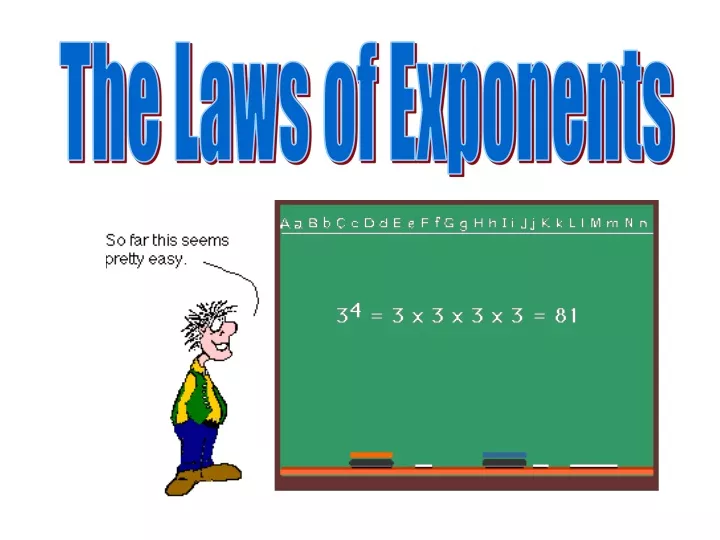

The Laws of Exponents
Jan 03, 2020
480 likes | 729 Views
The Laws of Exponents. Exponents. exponent. Power. base. 5 3 means 3 factors of 5 or 5 x 5 x 5. The Laws of Exponents:. Exponential form: The exponent of a power indicates how many times the base multiplies itself. n factors of x.
Share Presentation
- multiplying powers
- dividing powers
- multiply powers
- 4 negative law
- 2 dividing powers quotient

Presentation Transcript
Exponents exponent Power base 53 means 3 factors of 5 or 5 x 5 x 5
The Laws of Exponents: Exponential form:The exponent of a power indicates how many times the base multiplies itself. n factors of x
#1: Multiplying Powers (Product of Powers): If you are multiplying Powers with the same base, KEEP the BASE & ADD the EXPONENTS! So, I get it! When you multiply Powers, you add the exponents!
#2: Dividing Powers (Quotient of Powers):When dividing Powers with the same base, KEEP the BASE & SUBTRACT the EXPONENTS! So, I get it! When you divide Powers, you subtract the exponents!
#3: Power of a Power:If you are raising a Power to an exponent, you multiply the exponents! So, when I take a Power to a power, I multiply the exponents
#5: Product Law of Exponents:If the product of the bases is powered by the same exponent, then the result is a multiplication of individual factors of the product, each powered by the given exponent. So, when I take a Power of a Product, I apply the exponent to all factors of the product.
#6: Quotient Law of Exponents:If the quotient of the bases is powered by the same exponent, then the result is both numerator and denominator , each powered by the given exponent. So, when I take a Power of a Quotient, I apply the exponent to all parts of the quotient.
#4: Negative Law of Exponents:If the base is powered by the negative exponent, then the base becomes reciprocal with the positive exponent. So, when I have a Negative Exponent, I switch the base to its reciprocal with a Positive Exponent. Ha Ha! If the base with the negative exponent is in the denominator, it moves to the numerator to lose its negative sign!
#5: Zero Law of Exponents:Any base powered by zero exponent equals one. So zero factors of a base equals 1. That makes sense! Every power has a coefficient of 1.
- More by User

Laws of Exponents Practice using PowerPoint
Laws of Exponents. Compute: 25. Answer: 32. Laws of Exponents. Compute: 5-2. Answer: 1/25. Laws of Exponents. Compute: 02. Answer: 0. Laws of Exponents. Compute: 20. Answer: 1. Laws of Exponents. Compute: 00. Answer: ??. Laws of Exponents. Compute: - 42. Answer: -16. Laws of Exponents. C
987 views • 25 slides

8.1 Laws of Exponents: Multiplying Monomials
8.1 Laws of Exponents: Multiplying Monomials. Objectives: Define exponents and powers. Find products of powers. Simplify products of monomials.
356 views • 12 slides
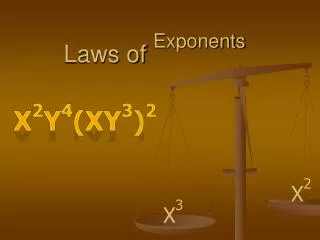
Laws of Exponents
Laws of Exponents. x 2 y 4 (xy 3 ) 2. X 2. X 3. Zero Rule. Any non-zero number raised to the zero power equals one X 0 = 1 Examples: 2 0 =1 99 0 = 1. That seems wrong! Anything to the zero power is equal to 1 !?!?.
609 views • 13 slides

Laws of Exponents. Zero Rule. Any non-zero number raised to the zero power equals one X 0 = 1 Examples: 2 0 =1 99 0 = 1. Rule of One. Any number raised to the power of one equals itself. x 1 =x Examples: 17 1 = 17 99 1 = 99.
424 views • 16 slides

The Laws of Exponents : Quotients
The Laws of Exponents : Quotients. #4: Quotient of two powers with equal bases: If you divide the same bases, then subtract the bottom exponent from the top exponent. The Laws of Exponents : Quotients. #5: Power of a quotient: Exponentiation distributes over division.
491 views • 5 slides

The Laws of Exponents. Exponential Form:. exponent. base. Laws of Exponents:. Multiplying Dividing Power to a Power Zero Power Negative Exponents. 1. Multiplying Exponents. 3 2 × 3 3 = ( 4 3 )(4 4 ) = 6 5 · 6 = Now try these: ( 8 5 )(3 2 ) = 2 3 × 3 2 =.
8.76k views • 18 slides

Laws of Exponents. Whenever we have variables which contain exponents and have the same base, we can do certain mathematical operations to them. Those operations are called the “Laws of Exponents”. b x b = base x = exponent. Laws of Exponents.
1.33k views • 13 slides

Laws of Exponents. Objective: TSW simplify powers. TSW simplify radicals. TSW develop a vocabulary associated with exponents. TSW use the laws of exponents to simplify. Exponents. The lower number is called the base and the upper number is called the exponent.
781 views • 38 slides
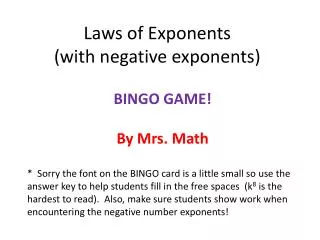
Laws of Exponents (with negative exponents)
Laws of Exponents (with negative exponents). BINGO GAME! By Mrs. Math.
987 views • 41 slides
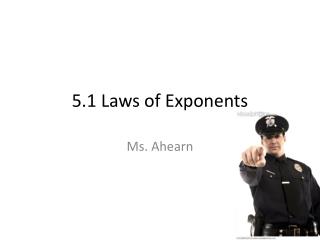
5.1 Laws of Exponents
5.1 Laws of Exponents. Ms. Ahearn. GROUPS:. Scientific Notation. How Many Stars in the Universe?. 120,000 LY= Diameter of Milky Way. 13.8 Billion LY = Diameter of Visible Universe. 400 Billion in Milky Way. http:// www.youtube.com/watch?v =WuqB3aB6-RI. Stars in the Solar System?. HMWK:.
224 views • 9 slides

The Laws of Exponents. Exponents. exponent. (Power). base. 5 3 means 3 factors of 5 or 5 x 5 x 5. The Laws of Exponents:. #1: Exponential form: The exponent indicates how many times the base multiplies itself. n factors of x.
1.18k views • 19 slides

Laws of Exponents. Let’s dig deep into our memories and try to remember the laws of exponents. Product Rule. Quotient Rule. It’s all coming back now. I remember this stuff. Laws of Logarithms. What are the Laws of Logarithms?.
2.01k views • 8 slides
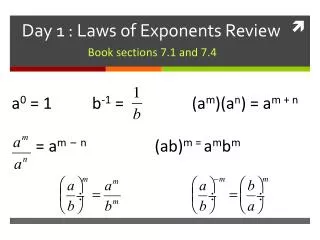
Day 1 : Laws of Exponents Review
Day 1 : Laws of Exponents Review. Book sections 7.1 and 7.4. a 0 = 1 b -1 = (a m )(a n ) = a m + n = a m – n (ab) m = a m b m. Do not copy:. Objective: TLW Simplify radicals Simplify with rational exponents
423 views • 19 slides

This powerpoint will help you when working on “ Exponenet Patterning”. Welcome to your personal lesson about the laws of exponents. I hope you enjoy your experience! Here are some things you need to know:
1.14k views • 74 slides

Laws of Exponents. 7-2 through 7-4. What we call expanded notation. What we call expanded notation. What we call expanded notation. Putting it all together…. Putting it all together… =3 3 3 3 3 3. Putting it all together… =3 3 3 3 3 3
2.24k views • 205 slides
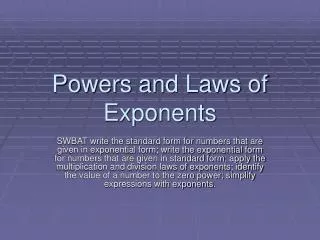
Powers and Laws of Exponents
Powers and Laws of Exponents.
660 views • 6 slides

Laws of Exponents. By Chancy Nordick. Review. What exactly is a power function again?. A power function has two parts:. Exponent. Base. Review Continued. Where. And. Multiplication Laws. What if we want to multiply two power functions?. Example:. Multiplication Laws. In General.
615 views • 39 slides

The Laws of Exponents. Exponents. exponent. Power. base. 5 3 means 3 factors of 5 or 5 x 5 x 5. The Laws of Exponents:. #1: Exponential form: The exponent of a power indicates how many times the base multiplies itself. n factors of x.
551 views • 19 slides

Self-learning study material
91 views • 7 slides

255 views • 19 slides

Laws of Exponents. Vocabulary. Factor: an integer that divides into another integer with no remainder. 24. 1, 2, 3, 4, 6, 8, 12, 24. Exponent: tells how many times to multiply a number by itself Base: the number that is multiplied by itself
365 views • 8 slides

8.1 Laws of Exponents
8.1 Laws of Exponents. Whenever we have variables which contain exponents and have equal bases, we can do certain mathematical operations to them. Those operations are called the “Laws of Exponents”. b x b = base x = exponent. Laws of Exponents.
446 views • 21 slides
Got any suggestions?
We want to hear from you! Send us a message and help improve Slidesgo
Top searches
Trending searches

suicide prevention
8 templates

46 templates

tropical rainforest
29 templates

spring season
34 templates

american football
16 templates

32 templates
Properties of Exponents
Premium template.
To keep enjoying the content of these slides, you must be a Premium user. Become Premium from €1.67 per month!
Properties of Exponents Presentation
Premium google slides theme and powerpoint template.
Are you ready to level up your math skills? Get ready to learn the properties of exponents with this fun, visual template! This simple design features a doodle-style visual with a playful font to help your students stay engaged throughout the lesson. They'll learn about the power of exponents, the rules of multiplication and division, and how to apply the properties in real-examples. Get your calculator and start learning!
Features of this template
- Designed for High School
- 100% editable and easy to modify
- 11 different slides to impress your audience
- Contains easy-to-edit graphics such as graphs, maps, tables, timelines and mockups
- Includes 500+ icons and Flaticon’s extension for customizing your slides
- Designed to be used in Google Slides and Microsoft PowerPoint
- 16:9 widescreen format suitable for all types of screens
- Includes information about fonts, colors, and credits of the resources used
- Available in different languages
What are the benefits of having a Premium account?
What Premium plans do you have?
What can I do to have unlimited downloads?
Don’t want to attribute Slidesgo?
Gain access to over 22700 templates & presentations with premium from 1.67€/month.
Are you already Premium? Log in
Available in
Related posts on our blog.

How to Add, Duplicate, Move, Delete or Hide Slides in Google Slides

How to Change Layouts in PowerPoint

How to Change the Slide Size in Google Slides
Related presentations.

Unlock this template and gain unlimited access

Register for free and start editing online

- My presentations
Auth with social network:
Download presentation
We think you have liked this presentation. If you wish to download it, please recommend it to your friends in any social system. Share buttons are a little bit lower. Thank you!
Presentation is loading. Please wait.
Presentation on theme: "Laws of Exponents: Multiplication."— Presentation transcript:
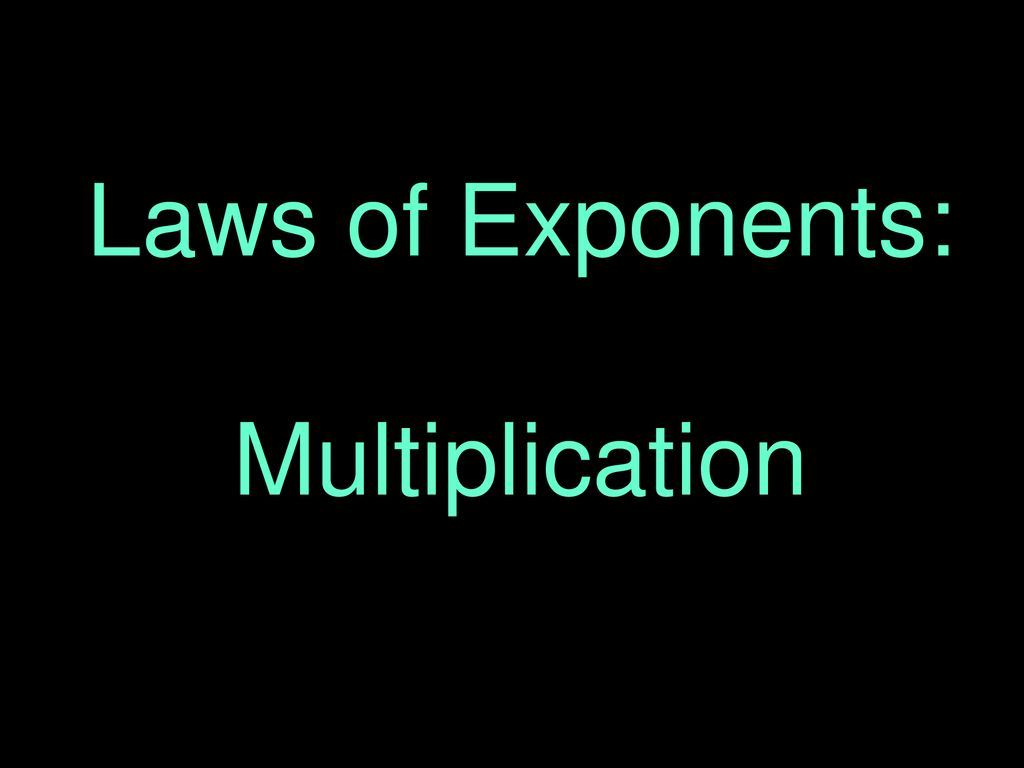
Simplifying a Variable Expression

Laws of Exponents: Dividing Monomials Division Rules for Exponents.

Multiplication Rules for Exponents

Properties of Exponents

Lesson #3- Exponent Laws

WARM UP 3 SIMPLIFY THE EXPRESSION ● (2 3 ) 2.

Multiplying and Dividing Monomials 4.3 Monomial: An expression that is either a: (1) numeral or constant, ex : 5 (2)a v ariable, ex: x (3)or a product.

Chapter 6 Polynomial Functions and Inequalities. 6.1 Properties of Exponents Negative Exponents a -n = –Move the base with the negative exponent to the.

Section 8.1. Exponents are a short hand way to write multiplication Examples: 4 ·4 = 4 2 4·4·4 = 4 3 4·4·x·x·x= 4 2 x 3 = 16 x 3.

P ROPERTIES OF E XPONENTS. P RE -T EST Q UESTION 1 y 3 y 4 A.) y 12 B.) y 7 C.) y -1 D.) y.

Laws of Exponents. Review An exponent tells you how many times the base is multiplied by itself. h 5 means h∙ h∙ h∙ h∙ h Any number to the zero power.

Secret Signal … on your chest “1” if true “2” if false 2 3 = (2)(2)(2)

Review of Properties of Exponents. a 0 = 1, a 0 Properties of Exponents Assume throughout your work that no denominator is equal to zero and that m.

Ch 8: Exponents B) Zero & Negative Exponents

California Standards AF2.2 Multiply and divide monomials; extend the process of taking powers and extracting roots to monomials when the latter results.

Evaluating Algebraic Expressions 4-4 Multiplying and Dividing Monomials Math humor: Question: what has variables with whole-number exponents and a bunch.

Chapter 8.1. Lesson Objective: NCSCOS 1.01 – Write the equivalent forms of algebraic expressions to solve problems Students will know how to apply.

6.1 - Polynomials. Monomial Monomial – 1 term Monomial – 1 term; a variable.

Example Divide 2y 2 – 6y + 4g – 8 by 2. 2y 2 – 6y + 4g y 2 – 6y + 4g Simply divide each term by 2 y 2 – 3y + 2g - 4.

Aim: How do we work on the expression with negative or zero exponent?
About project
© 2024 SlidePlayer.com Inc. All rights reserved.

- school Campus Bookshelves
- menu_book Bookshelves
- perm_media Learning Objects
- login Login
- how_to_reg Request Instructor Account
- hub Instructor Commons
- Download Page (PDF)
- Download Full Book (PDF)
- Periodic Table
- Physics Constants
- Scientific Calculator
- Reference & Cite
- Tools expand_more
- Readability
selected template will load here
This action is not available.

5.5: Laws of Exponents
- Last updated
- Save as PDF
- Page ID 19881

- David Arnold
- College of the Redwoods
In Chapter 1, section 1, we first introduced the definition of an exponent. For convenience, we repeat that definition.
In the exponential expression \(a^n\), the number \(a\) is called the base, while the number \(n\) is called the exponent.
Let \(a\) be any real number and let \(n\) be any whole number. If \(n \neq 0\), then:
\[a^{n}=\underbrace{a \cdot a \cdot a \cdots \cdot a}_{n \text { times }} \nonumber \]
That is, to calculate \(a^n\), write \(a\) as a factor \(n\) times. In the case where \(a \neq 0\), but \(n = 0\), then we define:
\[a^0 =1 \nonumber \]
For example, raising a number to the fifth power requires that we repeat the number as a factor five times (see Figure \(\PageIndex{1}\)).
\[\begin{aligned}(-2)^{5} &=(-2)(-2)(-2)(-2)(-2) \\ &=-32 \end{aligned} \nonumber \]
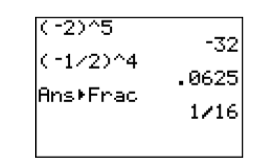
Raising a number to the fourth power requires that we repeat that number as a factor four times (see Figure \(\PageIndex{1}\)).
\[\begin{aligned}\left(-\dfrac{1}{2}\right)^{4} &=\left(-\dfrac{1}{2}\right)\left(-\dfrac{1}{2}\right)\left(-\dfrac{1}{2}\right)\left(-\dfrac{1}{2}\right) \\ &=\dfrac{1}{16} \end{aligned} \nonumber \]
As a final example, note that \(10^0 = 1\), but \(0^0\) is undefined (see Figure \(\PageIndex{2}\)).

For those who may be wondering why \(a^0 = 1\), provided \(a \neq 0\) , here is a nice argument. First, note that \(a^1 = a\), so:
\[a \cdot a^{0}=a^{1} \cdot a^{0} \nonumber \]
On the right, repeat the base and add the exponents.
\[a \cdot a^{0}=a^{1} \nonumber \]
Or equivalently:
\[a \cdot a^{0}=a \nonumber \]
Now, divide both sides by \(a\), which is permissible if \(a \neq 0\) .
\[\dfrac{a \cdot a^{0}}{a}=\dfrac{a}{a} \nonumber \]
Simplify both sides:
Multiplying With Like Bases
In the expression \(a^n\), the number \(a\) is called the base and the number \(n\) is called the exponent . Frequently, we’ll be required to multiply two exponential expressions with like bases, such as \(x^{3} \cdot x^{4}\). Recall that the exponent tells us how many times to write each base as a factor, so we can write:
\[\begin{aligned} x^{3} \cdot x^{4} &=(x \cdot x \cdot x) \cdot(x \cdot x \cdot x \cdot x) \\ &=x \cdot x \cdot x \cdot x \cdot x \cdot x \cdot x \\ &=x^{7} \end{aligned} \nonumber \]
Note that we are simply counting the number of times that \(x\) occurs as a factor. First, we have three \(x’s\), then four \(x’s\), for a total of seven \(x’s\). However a little thought tells us that it is much quicker to simply add the exponents to reveal the total number of times \(x\) occurs as a factor.
\[\begin{aligned} x^{3} \cdot x^{4} &=x^{3+4} \\ &=x^{7} \end{aligned} \nonumber \]
The preceding discussion is an example of the following general law of exponents.
To multiply two exponential expressions with like bases, repeat the base and add the exponents.
\[a^{m} \cdot a^{n}=a^{m+n} \nonumber \]
Example \(\PageIndex{1}\)
Simplify each of the following expressions:
- \(y^{4} \cdot y^{8}\)
- \(2^{3} \cdot 2^{5}\)
- \((x+y)^{2}(x+y)^{7}\)
In each example we have like bases. Thus, the approach will be the same for each example: repeat the base and add the exponents.
- \(\begin{aligned} y^{4} \cdot y^{8} &=y^{4+8} \\ &=y^{12} \end{aligned}\)
- \(\begin{aligned} 2^{3} \cdot 2^{5} &=2^{3+5} \\ &=2^{8} \end{aligned}\)
- \(\begin{aligned}(x+y)^{2}(x+y)^{7} &=(x+y)^{2+7} \\ &=(x+y)^{9} \end{aligned}\)
With a little practice, each of the examples can be simplified mentally. Repeat the base and add the exponents in your head: \(y^{4} \cdot y^{8}=y^{12}, 2^{3} \cdot 2^{5}=2^{8}\) and \((x+y)^{2}(x+y)^{7}=(x+y)^{9}\).
Exercise \(\PageIndex{1}\)
\(3^{4} \cdot 3^{2}\)
Example \(\PageIndex{2}\)
Simplify: \(\left(a^{6} b^{4}\right)\left(a^{3} b^{2}\right)\)
We’ll use the commutative and associative properties to change the order of operation, then repeat the common bases and add the exponents.
\[\begin{aligned} \left(a^{6} b^{4}\right)\left(a^{3} b^{2}\right) &= a^{6} b^{4} a^{3} b^{2} \quad \color {Red} \text { The associative property allows us to regroup in the order we prefer. } \\ &= a^{6} a^{3} b^{4} b^{2} \quad \color {Red} \text { The commutative property allows us to change the order of multiplication. } \\ &= a^{9} b^{6} \quad \color {Red} \text { Repeat the common bases and add the exponents. } \end{aligned} \nonumber \]
With practice, we realize that if all of the operators are multiplication, then we can multiply in the order we prefer, repeating the common bases and adding the exponents mentally: \(\left(a^{6} b^{4}\right)\left(a^{3} b^{2}\right)=a^{9} b^{6}\).
Exercise \(\PageIndex{2}\)
\(\left(x^{2} y^{6}\right)\left(x^{4} y^{3}\right)\)
\(x^{6} y^{9}\)
Example \(\PageIndex{3}\)
Simplify: \(x^{n+3} \cdot x^{3-2 n}\)
Again, we repeat the base and add the exponents.
\[\begin{aligned} x^{n+3} \cdot x^{3-2 n} &= x^{(n+3)+(3-2 n)} \quad \color {Red}\text { Repeat the base, add the exponents. } \\ &= x^{6-n} \quad \color {Red} \text { Simplify. Combine like terms. } \end{aligned} \nonumber \]
Exercise \(\PageIndex{3}\)
\(x^{5-n} \cdot x^{4 n+2}\)
\(x^{3 n+7}\)
Dividing With Like Bases
Like multiplication, we will also be frequently asked to divide exponential expressions with like bases, such as \(x^7/x^4\). Again, the key is to remember that the exponent tells us how many times to write the base as a factor, so we can write:
\[\begin{aligned} \dfrac{x^{7}}{x^{4}} &= \dfrac{x \cdot x \cdot x \cdot x \cdot x \cdot x \cdot x}{x \cdot x \cdot x \cdot x} \\ &= \dfrac{\not {x} \cdot \not {x} \cdot \not{x} \cdot \not {x} \cdot x \cdot x \cdot x}{\not {x} \cdot \not {x} \cdot \not {x} \cdot \not {x}} \\ &= x^3 \end{aligned} \nonumber\]
Note how we cancel four \(x’s\) in the numerator for four \(x’s\) in the denominator. However, in a sense we are “subtracting four \(x’s\)” from the numerator, so a faster way to proceed is to repeat the base and subtract the exponents, as follows:
\[\begin{aligned} \dfrac{x^{7}}{x^{4}} &=x^{7-4} \\ &=x^{3} \end{aligned} \nonumber \]
The preceding discussion is an example of the second general law of exponents.
How to Divide with Like Bases
To divide two exponential expressions with like bases, repeat the base and subtract the exponents. Given \(a \neq 0\),
\[\dfrac{a^{m}}{a^{n}}=a^{m-n} \nonumber \]
Note that the subtraction of the exponents follows the rule “top minus bottom.”
Here is another nice argument why \(a^0 = 1\), provided \(a \neq 0\). Start with:
\[\dfrac{a^{1}}{a^{1}}=1 \nonumber \]
Repeat the base and subtract the exponents.
\[a^{1-1}=1 \nonumber \]
\[a^0 = 1 \nonumber \]
Example \(\PageIndex{4}\)
- \(\dfrac{x^{12}}{x^{3}}\)
- \(\dfrac{5^{7}}{5^{7}}\)
- \(\dfrac{(2 x+1)^{8}}{(2 x+1)^{3}}\)
In each example we have like bases. Thus, the approach will be the same for each example: repeat the base and subtract the exponents.
- \(\begin{aligned} \dfrac{x^{12}}{x^{3}} &=x^{12-3} \\ &=x^{9} \end{aligned}\)
- \(\begin{aligned} \dfrac{5^{7}}{5^{7}} &=5^{7-7} \\ &=5^{0} \\ &=1 \end{aligned}\)
- \(\begin{aligned} \dfrac{(2 x+1)^{8}}{(2 x+1)^{3}} &=(2 x+1)^{8-3} \\ &=(2 x+1)^{5} \end{aligned}\)
With a little practice, each of the examples can be simplified mentally. Repeat the base and subtract the exponents in your head: \(x^{12} / x^{3}=x^{9}, 5^{7} / 5^{4}=5^{3}\) and \((2 x+1)^{8} /(2 x+1)^{3}=(2 x+1)^{5}\).
Exercise \(\PageIndex{4}\)
\(\dfrac{4^{5}}{4^{3}}\)
Example \(\PageIndex{5}\)
Simplify: \(\dfrac{12 x^{5} y^{7}}{4 x^{3} y^{2}}\)
We first express the fraction as a product of three fractions, the latter two with a common base. In the first line of the following solution, note that if you multiply numerators and denominators of the three separate fractions, the product equals the original fraction on the left.
\[\begin{aligned} \dfrac{12 x^{5} y^{7}}{4 x^{3} y^{2}} &= \dfrac{12}{4} \cdot \dfrac{x^{5}}{x^{3}} \cdot \dfrac{y^{7}}{y^{2}} \quad \color {Red} \text { Break into a product of three fractions. } \\ &= 3 x^{5-3} y^{7-2} \quad \color {Red} \text { Simplify: } 12 / 4=3 . \text { Then repeat the common } \\ &= 3 x^{2} y^{5} \quad \color {Red} \text { Simplify. } \end{aligned} \nonumber \]
Exercise \(\PageIndex{5}\)
Simplify: \(\dfrac{15 a^{6} b^{9}}{3 a b^{5}}\)
\(5 a^{5} b^{4}\)
Example \(\PageIndex{6}\)
Simplify: \(\dfrac{x^{5 n-4}}{x^{3-2 n}}\)
Again, we repeat the base and subtract the exponents.
\[\begin{aligned} \dfrac{x^{5 n-4}}{x^{3-2 n}} &= x^{(5 n-4)-(3-2 n)} \quad \color {Red} \text { Repeat the base, subtract exponents. } \\ &= x^{5 n-4-3+2 n} \quad \color {Red} \text { Distribute the minus sign. } \\ &= x^{7 n-7} \quad \color {Red} \text { Simplify. Combine like terms. } \end{aligned} \nonumber \]
Exercise \(\PageIndex{6}\)
Simplify: \(\dfrac{x^{3 n-6}}{x^{n+2}}\)
\(x^{2 n-8}\)
Raising a Power to a Power
Suppose we have an exponential expression raised to a second power, such as \((x^2)3\). The second exponent tells us to write \(x^2\) as a factor three times:
\[\begin{aligned} \left(x^{2}\right)^{3} &= x^{2} \cdot x^{2} \cdot x^{2} \quad \color {Red} \text { Write } x^{2} \text { as a factor three times. } \\ &= x^{6} \quad \color {Red} \text { Repeat the base, add the exponents. } \end{aligned} \nonumber \]
Note how we added \(2 + 2 + 2\) to get \(6\). However, a much faster way to add “three twos” is to multiply: \(3 \cdot 2=6\). Thus, when raising a “power to a second power,” repeat the base and multiply the exponents, as follows:
\[\begin{aligned}\left(x^{2}\right)^{3} &=x^{2 \cdot 3} \\ &=x^{6} \end{aligned} \nonumber \]
The preceding discussion gives rise to the following third law of exponents.
When raising a power to a power, repeat the base and multiply the exponents. In symbols: \[(a^m)^n = a^{mn} \nonumber \] Note that juxtaposing two variables, as in \(mn\), means “\(m\) times \(n\).”
Example \(\PageIndex{7}\)
- \(\left(z^{3}\right)^{5}\)
- \(\left(7^{3}\right)^{0}\)
- \(\left[(x-y)^{3}\right]^{6}\)
In each example we are raising a power to a power. Hence, in each case, we repeat the base and multiply the exponents.
- \(\begin{aligned}\left(z^{3}\right)^{5} &=z^{3.5} \\ &=z^{15} \end{aligned}\)
- \(\begin{aligned}\left(7^{3}\right)^{0} &=7^{3.0} \\ &=7^{0} \\ &=1 \end{aligned}\)
- \(\begin{aligned}\left[(x-y)^{3}\right]^{6} &=(x-y)^{3 \cdot 6} \\ &=(x-y)^{18} \end{aligned}\)
With a little practice, each of the examples can be simplified mentally. Repeat the base and multiply the exponents in your head: \(\left(z^{3}\right)^{5}=z^{15},\left(7^{3}\right)^{4}=7^{12}\) and \(\left[(x-y)^{3}\right]^{6}=(x-y)^{18}\).
Exercise \(\PageIndex{7}\)
Simplify: \(\left(2^{3}\right)^{4}\)
Example \(\PageIndex{8}\)
Simplify: \(\left(x^{2 n-3}\right)^{4}\)
Again, we repeat the base and multiply the exponents.
\[\begin{aligned} \left(x^{2 n-3}\right)^{4} &= x^{4(2 n-3)} \quad \color {Red} \text { Repeat the base, multiply exponents. } \\ &= x^{8 n-12} \quad \color {Red} \text { Distribute the } 4 . \end{aligned} \nonumber \]
Exercise \(\PageIndex{8}\)
Simplify: \(\left(a^{2-n}\right)^{3}\)
\(a^{6-3 n}\)
Raising a Product to a Power
We frequently have need to raise a product to a power, such as \((xy)^3\). Again, remember the exponent is telling us to write \(xy\) as a factor three times, so:
\[\begin{aligned} (x y)^{3} &=(x y)(x y)(x y) \quad \color {Red} \text {Write } xy \text { as a factor three times.}\\ &=x y x y x y \quad \color {Red} \text {The associative property allows us to group as we please.}\\ &=x x x y y y \quad \color {Red} \text {The commutative property allows us to change the order as we please.}\\ &=x^{3} y^{3} \quad \color {Red} \text {Invoke the exponent definition: } x x x=x^{3} \text { and } y y y=y^{3} \end{aligned} \nonumber \]
However, it is much simpler to note that when you raise a product to a power, you raise each factor to that power. In symbols: \[(xy)^3 = x^3y^3 \nonumber \] The preceding discussion leads us to a fourth law of exponents.
To raise a product to a power, raise each factor to that power. In symbols:
\[(ab)^n = a^nb^n \nonumber \]
Example \(\PageIndex{9}\)
- \((y z)^{5}\)
- \((-2 x)^{3}\)
- \((-3 y)^{2}\)
In each example we are raising a product to a power. Hence, in each case, we raise each factor to that power.
- \((y z)^{5}=y^{5} z^{5}\)
- \(\begin{aligned}(-2 x)^{3} &=(-2)^{3} x^{3} \\ &=-8 x^{3} \end{aligned}\)
- \(\begin{aligned}(-3 y)^{2} &=(-3)^{2} y^{2} \\ &=9 y^{2} \end{aligned}\)
With a little practice, each of the examples can be simplified mentally. Raise each factor to the indicated power in your head: \((y z)^{5}=y^{5} z^{5},(-2 x)^{3}=-8 x^{3}\) and \((-3 y)^{2}=9 y^{2}\)
Exercise \(\PageIndex{9}\)
Simplify: \((-2 b)^{4}\)
\(16 b^{4}\)
When raising a product of three factors to a power, it is easy to show that we should raise each factor to the indicated power. For example, \((a b c)^{3}=a^{3} b^{3} c^{3}\). In general, this is true regardless of the number of factors. When raising a product to a power, raise each of the factors to the indicated power.
Example \(\PageIndex{10}\)
Simplify: \(\left(-2 a^{3} b^{2}\right)^{3}\)
Raise each factor to the third power, then simplify.
\[\begin{aligned} \left(-2 a^{3} b^{2}\right)^{3} &= (-2)^{3}\left(a^{3}\right)^{3}\left(b^{2}\right)^{3} \quad \color {Red} \text { Raise each factor to the third power. } \\ &= -8 a^{9} b^{6} \quad \color {Red} \text {Simplify: } (-2)^{3}=8 \text {. In the remaining factors, raising a power to a power requires that we multiply the exponents. } \end{aligned} \nonumber \]
Exercise \(\PageIndex{10}\)
Simplify: \(\left(-3 x y^{4}\right)^{5}\)
\(-243 x^{5} y^{20}\)
Example \(\PageIndex{11}\)
Simplify: \(\left(-2 x^{2} y\right)^{2}\left(-3 x^{3} y\right)\)
In the first grouped product, raise each factor to the second power.
\[\begin{aligned} \left(-2 x^{2} y\right)^{2}\left(-3 x^{3} y\right) &=\left((-2)^{2}\left(x^{2}\right)^{2} y^{2}\right)\left(-3 x^{3} y\right) \quad \color {Red} \text { Raise each factor in the first grouped product to the second power.} \\ &=\left(4 x^{4} y^{2}\right)\left(-3 x^{3} y\right) \quad \color {Red} \text { Simplify: } (-2)^{2}=4 \text { and } \left(x^{2}\right)^{2}=x^{4} \end{aligned} \nonumber \]
The associative and commutative property allows us to multiply all six factors in the order that we please. Hence, we’ll multiply \(4\) and \(−3\), then \(x^4\) and \(x^3\), and \(y^2 and y, in that order. In this case, we repeat the base and add the exponents.
\[\begin{aligned} &=-12x^7y^3 \quad \color {Red} \text { Simplify: } (4)(-3)=-12. \text { Also, } x^{4}x^3=x^{7} \text { and } y^2y = y^3\end{aligned} \nonumber\]
Exercise \(\PageIndex{11}\)
Simplify: \(\left(-a^{3} b^{2}\right)^{3}\left(-2 a^{2} b^{4}\right)^{2}\)
\(-4 a^{13} b^{14}\)
Raising a Quotient to a Power
Raising a quotient to a power is similar to raising a product to a power. For example, raising \((x/y)^3\) requires that we write \(x/y\) as a factor three times.
\[\begin{aligned}\left(\frac{x}{y}\right)^{3} &=\frac{x}{y} \cdot \frac{x}{y} \cdot \frac{x}{y} \\ &=\frac{x \cdot x \cdot x}{y \cdot y \cdot y} \\ &=\frac{x^{3}}{y^{3}} \end{aligned} \nonumber \]
However, it is much simpler to realize that when you raise a quotient to a power, you raise both numerator and denominator to that power. In symbols:
\[\left(\dfrac{x}{y}\right)^{3}=\frac{x^{3}}{y^{3}} \nonumber \]
This leads to the fifth and final law of exponents.
To raise a quotient to a power, raise both numerator and denominator to that power. Given \(b \neq 0\),
\[\left(\dfrac{a}{b}\right)^{n}=\dfrac{a^{n}}{b^{n}} \nonumber \]
Example \(\PageIndex{12}\)
- \(\left(\dfrac{2}{3}\right)^{2}\)
- \(\left(\dfrac{x}{3}\right)^{3}\)
- \(\left(-\dfrac{2}{y}\right)^{4}\)
In each example we are raising a quotient to a power. Hence, in each case, we raise both numerator and denominator to that power.
- \(\begin{aligned}\left(\dfrac{2}{3}\right)^{2} &=\dfrac{2^{2}}{3^{2}} \\ &=\dfrac{4}{9} \end{aligned}\)
- \(\begin{aligned}\left(\dfrac{x}{3}\right)^{3} &=\dfrac{x^{3}}{3^{3}} \\ &=\dfrac{x^{3}}{27} \end{aligned}\)
- \(\begin{aligned}\left(-\dfrac{2}{y}\right)^{4} &=\dfrac{2^{4}}{y^{4}} \\ &=\dfrac{16}{y^{4}} \end{aligned}\)
Note that in example (c), raising a negative base to an even power produces a positive result. With a little practice, each of the examples can be simplified mentally. Raise numerator and denominator to the indicated power in your head: \((2 / 3)^{2}=4 / 9,(x / 3)^{3}=x^{3} / 27,\) and \((-2 / y)^{4}=16 / y^{4}\)
Exercise \(\PageIndex{12}\)
Simplify: \(\left(\dfrac{5}{4}\right)^{3}\)
\(\dfrac{125}{64}\)
Example \(\PageIndex{13}\)
Simplify: \(\left(\dfrac{2 x^{5}}{y^{3}}\right)^{2}\)
Raise both numerator and denominator to the second power, then simplify:
\[\begin{aligned} \left(\dfrac{2 x^{5}}{y^{3}}\right)^{2}=\dfrac{\left(2 x^{5}\right)^{2}}{\left(y^{3}\right)^{2}} \quad \color {Red} \text {Raise numerator and denominator to the second power.} \end{aligned} \nonumber\]
In the numerator, we need to raise each factor of the product to the second power. Then we need to remind ourselves that when we raise a power to a power, we multiply the exponents.
\[\begin{aligned} &= \dfrac{2^{2}\left(x^{5}\right)^{2}}{\left(y^{3}\right)^{2}} \quad \color {Red} \text {Raise each factor in the numerator and denominator to the second power.} \\ &= \dfrac{4 x^{10}}{y^{6}} \quad \color {Red} \text { Simplify: } 2^{2}=4,\left(x^{5}\right)^{2}=x^{10} \text {, and } (y^3)^2=y^6 \end{aligned} \nonumber\]
Exercise \(\PageIndex{13}\)
Simplify: \(\left(\dfrac{a^{4}}{3 b^{2}}\right)^{3}\)
\(\dfrac{a^{12}}{27 b^{6}}\)
Laws of exponents
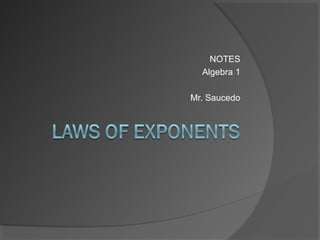
Recommended
More related content, what's hot, what's hot ( 20 ), similar to laws of exponents, similar to laws of exponents ( 14 ), more from masljr, more from masljr ( 20 ), recently uploaded, recently uploaded ( 20 ).
- 1. NOTES Algebra 1 Mr. Saucedo
- 2. REVIEW Recall: A number in exponential form has a base and an exponent. The exponent indicates how many times the base is used as a factor. In its exponential form: ab , a is the BASE and b is the EXPONENT.
- 3. NOTES The laws of exponents show how to __SIMPLIFY___ expressions in exponential form.
- 4. NOTES In the next few slides, a and b are real numbers and m and n are integers.
- 5. PRODUCT OF POWERS To multiply powers with the same base, add the exponents. am ∙an = am+n
- 6. POWER OF A POWER To raise a number in exponential form to a power, multiply the exponents. (am )n = am∙n
- 7. POWER OF A PRODUCT To find a power of a product, find the power of each factor and multiply. (ab)m = am bm
- 8. POWER OF ZERO Any nonzero number raised to the power of zero is one. a0 = 1
- 9. QUOTIENT OF POWERS To find the quotient of powers with the same base, subtract the exponents. am = am-n an
- 10. POWER OF A QUOTIENT To raise a quotient to a power, raise both the numerator and denominator to that power. (a/b)m = am /bm
- 11. RECIPROCALS To change a sign of an exponent, move the expression to the denominator of a fraction, or to the numerator. a-n = 1/an 1/a-n = an
- 12. GUIDED PRACTICE Simplify: 1. (x3 y2 z0 )3 2. (x4 y5 /xy2 )2
- 13. GUIDED PRACTICE 3. What is the value of the expression 6-3 ? 4. What is the result when a4 b-3 is divided by a-2 b2
- 14. CHECKPOINT Simplify: 1. (4m3 n3 )2 2. x3 y-2 /y4 3. (5a)2 b5 /(3a4 b2 ) 4. (3b2 x-2 y6 )0
- 15. INDEPENDENT PRACTICE Workbook, page 16. Problems 1 - 9.
Laws of Exponents
Exponents are also called Powers or Indices
The exponent of a number says how many times to use the number in a multiplication.
In this example: 8 2 = 8 × 8 = 64
Try it yourself:
So an Exponent saves us writing out lots of multiplies!
Example: a 7
a 7 = a × a × a × a × a × a × a = aaaaaaa
Notice how we wrote the letters together to mean multiply? We will do that a lot here.
Example: x 6 = xxxxxx
The key to the laws.
Writing all the letters down is the key to understanding the Laws
Example: x 2 x 3 = (xx)(xxx) = xxxxx = x 5
Which shows that x 2 x 3 = x 5 , but more on that later!
So, when in doubt, just remember to write down all the letters (as many as the exponent tells you to) and see if you can make sense of it.
All you need to know ...
The "Laws of Exponents" (also called "Rules of Exponents") come from three ideas :
If you understand those, then you understand exponents!
And all the laws below are based on those ideas.
Here are the Laws (explanations follow):
Laws Explained
The first three laws above ( x 1 = x , x 0 = 1 and x -1 = 1/x ) are just part of the natural sequence of exponents. Have a look at this:
Look at that table for a while ... notice that positive, zero or negative exponents are really part of the same pattern, i.e. 5 times larger (or 5 times smaller) depending on whether the exponent gets larger (or smaller).
The law that x m x n = x m+n
With x m x n , how many times do we end up multiplying "x"? Answer: first "m" times, then by another "n" times, for a total of "m+n" times.
So, x 2 x 3 = x (2+3) = x 5
The law that x m /x n = x m-n
Like the previous example, how many times do we end up multiplying "x"? Answer: "m" times, then reduce that by "n" times (because we are dividing), for a total of "m-n" times.
Example: x 4 /x 2 = (xxxx) / (xx) = xx = x 2
So, x 4 /x 2 = x (4-2) = x 2
(Remember that x / x = 1, so every time you see an x "above the line" and one "below the line" you can cancel them out.)
This law can also show you why x 0 =1 :
Example: x 2 /x 2 = x 2-2 = x 0 =1
The law that (x m ) n = x mn.
First you multiply "m" times. Then you have to do that "n" times , for a total of m×n times.
Example: (x 3 ) 4 = (xxx) 4 = (xxx)(xxx)(xxx)(xxx) = xxxxxxxxxxxx = x 12
So (x 3 ) 4 = x 3×4 = x 12
The law that (xy) n = x n y n
To show how this one works, just think of re-arranging all the "x"s and "y"s as in this example:
Example: (xy) 3 = (xy)(xy)(xy) = xyxyxy = xxxyyy = (xxx)(yyy) = x 3 y 3
The law that (x/y) n = x n /y n.
Similar to the previous example, just re-arrange the "x"s and "y"s
Example: (x/y) 3 = (x/y)(x/y)(x/y) = (xxx)/(yyy) = x 3 /y 3
The law that x m/n = n √ x m = ( n √ x ) m.
OK, this one is a little more complicated!
I suggest you read Fractional Exponents first, so this makes more sense.
Anyway, the important idea is that:
x 1/ n = The n- th Root of x
And so a fractional exponent like 4 3/2 is really saying to do a cube (3) and a square root (1/2), in any order.
Just remember from fractions that m/n = m × (1/n) :
Example: x ( m n ) = x (m × 1 n ) = (x m ) 1/n = n √ x m
The order does not matter, so it also works for m/n = (1/n) × m :
Example: x ( m n ) = x ( 1 n × m) = (x 1/n ) m = ( n √ x ) m
Exponents of exponents ....
What about this example?
We do the exponent at the top first , so we calculate it this way:

And That Is It!
If you find it hard to remember all these rules, then remember this:
you can work them out when you understand the three ideas near the top of this page:
- The exponent says how many times to use the number in a multiplication
- A negative exponent means divide
- A fractional exponent like 1/n means to take the nth root : x ( 1 n ) = n √ x
Oh, One More Thing ... What if x = 0?
The strange case of 0 0.
There are different arguments for the correct value of 0 0
0 0 could be 1, or possibly 0, so some people say it is really "indeterminate":
Laws of Exponents - Best PowerPoint Presentation | Lumos Learning
Laws of exponents, - by guest9c5e6b.
Laws of Exponents is related to Grade 5 and focuses on standards 5.NBT.2. This Lumos presentation viewer page not only allows you to view and download Laws of Exponents but also view questions, videos, apps, books and other resources related to 5.NBT.2.
Laws of Exponents is related to Grade 5 and focuses on standards 5.NBT.A.2. This Lumos presentation viewer page not only allows you to view and download Laws of Exponents but also view questions, videos, apps, books and other resources related to 5.NBT.A.2.
DESCRIPTION:
Additional information:, related presentations:, related presentations.
- Standard(s)

Related Questions:
Which one of the following sta...., resource: question, which of the following equatio...., related videos:.
Powers of Ten 5.NBT.2....
Resource: video.

[5.NBT.2-2.0] Multiplying/Divi....
Related pins:.

{FREE} Powers of Ten Task Card....
Resource: pin.

Powers of 10 Math Face Off 5.N....
Related books:, istep+ test prep: 4th grade ma...., resource: book, mississippi assessment program.....

- 888-309-8227
- 732-384-0146
Presentation Listings
- School Guide
- Mathematics
- Number System and Arithmetic
- Trigonometry
- Probability
- Mensuration
- Maths Formulas
- Class 8 Maths Notes
- Class 9 Maths Notes
- Class 10 Maths Notes
- Class 11 Maths Notes
- Class 12 Maths Notes
Laws of Exponents
- Rational Exponents
- Laws of Exponents for Real Numbers
- Fractional Exponents
- How to Multiply and Divide Exponents?
- Laws of Logarithms
- How do you express large numbers?
- Adding and Subtracting Exponents
- What is 125 in the exponential form?
- How to express a number as a power?
- Solve the expression: (7/3) (-3)
- What is 3 to the 2nd power mean?
- What is 6 to the 3rd power?
- What is 3 to the 2nd Power?
- Laws of Exponents & Use of Exponents to Express Small Numbers in Standard Form - Exponents and Powers | Class 8 Maths
- Find x in the following expression: (11/9) 3 × (9/11) 6 = (11/9) 2x-1
- Is 2 33 = 213 3 ?
- Evaluate (√4)-3
- Evaluate a 2 × a 3 × a -5
- What are Numbers?
- Propositional Logic
- Pigeonhole Principle
- L U Decomposition
- Set Theory - Definition, Types of Sets, Symbols & Examples
- Predicates and Quantifiers
- Binary to Decimal Converter
- Number System in Maths
- Puzzle 26 | (Know Average Salary without Disclosing Individual Salaries)
Laws of Exponents: Exponents are a way of representing very large or very small numbers. Exponent rules are the laws of the exponents that are used to solve various exponents’ problems. The multiplication, division, and other operations on exponents can be achieved using these laws of exponents. There are different rules of exponents also called laws of exponents in Mathematics and all these laws are added in the article below.
In this article, we will learn about Exponents Definition, Laws of Exponents, Laws of Exponents Examples, and others in detail.
Table of Content
Exponents Definition
What are exponent rules, what are laws of exponents, laws of exponents and logarithms, table: laws of exponents, exponent rules examples.
When a number is raised to some power then the power on the base number is called Exponent. Exponent simply means a base number is multiplied by itself equal to the power mentioned on it.
For Example, if we say P n this means P is multiplied by itself ‘n’ several times. It can be expanded as P×P×P×P×P×P . . . n times. Let’s say, 5 3 = 5 × 5 × 5 = 125; the equation is read as “five to the power of three.”
If the exponent is 2 then it is also known as “squared,” whereas if the exponent is 3 it is known as “cubed.” When calculating the area, the term ‘squared’ is used because we multiply the length (m/cm) two times and in the case of volume the term ‘cubed’ is used as we multiply the length (unit = m/cm) three times.
Exponent helps us to write very large as well as very small quantities. For instance, we can write large quantities such as the Mass of the Earth which is 5.97219×10 24 kg as well as very small quantities such as the Mass of the Electron which is 9.1×10 -31 kg.
Read in Detail: Exponents: Definition, Formulas, Laws, and Examples
Exponent rules are the rules that are used to solve exponent’s problems. Suppose we are given two exponents a m and a n and we have to find the product of the two exponents then we use the concept of exponents rule or product of exponents rule, i.e.
a m × a n = a (m+n)
Various other rules are used to solve exponent problems. These rules are called the exponents rule.
Laws of Exponents are the set of rules that help us to solve arithmetic problems in an easy manner. Since at times, we can get large exponents that make multiplication lengthy then with the help of laws of exponents, we can solve the problems easily and in time bound manner.
Following are the seven Laws of Exponents that we must know to solve arithmetic problems involving exponents:
Product of Powers Rule
Quotient of powers rule.
- Power of a Powers Rule
Power of a Quotient Rule
Zero power rule, negative exponent rule.
In the Product of Powers Rule , if two numbers with the same bases and different exponents are multiplied then exponents of the base are added to find the product. It is represented as x m ×x n = x (m+n)
Example: 5 2 × 5 3 =?
Keep the base values the same because they’re both five, and then add the exponents together (2+3). 5 2 × 5 3 = 5 2+3 = 5 5 To get the answer, multiply five by itself five times. 5 5 = 5 × 5 × 5 × 5 × 5 = 3125
In Quotient of Powers Rule , if two numbers with the same bases and different exponents are divided then the exponents of the base are subtracted to find the quotient. It is represented as x a ÷x b = x (a-b)
Example: 4 5 ÷ 4 3 =?
4 5 ÷ 4 3 =? Because both bases in this equation are four, they remain the same. Then subtract the divisor from the dividend using the exponents. 4 5 ÷ 4 3 = 4 5-3 = 4 2 Finally, if necessary, simplify the equation. 4 2 = 4 × 4 = 16
Power of a Power Rule
In Power of a Power Rule , if a number raised to some power is again raised to some power then the two powers will be multiplied. It is represented as (x m ) n = x m×n
Example: (2 3 ) 2 =?
(2 3 ) 2 =? Multiply the exponents together in equations like the one above while keeping the base constant. 2 3×2 = 2 6 However , we have to keep in mind that ((2^3)^2 ~\neq~2^{3^2} as (2 3 ) 2 = 2 6 but 2^{3^2} = 2^9 as only exponent 3 is again raised to exponent 2 and not the whole number including base.
Power of a Product Rule
In Power of a Product Rule , two different bases are raised to the same power are multiplied, then, bases are multiplied and power is common to the product of the bases. It is represented as (x m × y m ) = (xy) m . If the given question is (xy) m then distribute the exponent to each portion of the base when multiplying any base by an exponent, hence (xy) m = (x m × y m )
Example: 2 3 ×3 3 =?
Since the bases are different and the power is same then multiply the bases and raise it to the common power. Therefore, 2 3 ×3 3 =(2×3) 3 = 6 3 = 216
Example: (2×3) 3 =?
In this case separate the same power to individual bases. Hence, (2×3) 3 = 2 3 ×3 3 = 8×27 = 216
In Power of a Quotient Rule , if two different bases with the same power are divided then the result is the quotient of the bases raised to the same power. This is represented as x m /y m = (x/y) m . In this case, vice versa is also true i.e. if the both numerator and denominator are raised to the same power then power is distributed to both numerator and denominator individually. It can be represented as (x/y) m = x m /y m
Example: Simplify 6 4 /3 4 .
In this case, find the quotient of the bases and raise common power to it. 6 4 /3 4 = (6/3) 4 = 2 4 = 16
Example: Simplify (6/3) 4 .
In this case, distribute the power 4 to both the numerator and denominator. (6/3) 4 = 6 4 /3 4 = (6×6×6×6)/(3×3×3×3) = 2×2×2×2 = 16
In Zero Power Rule , if any base is raised to power zero, then the result will be 1. This can be represented as x 0 = 1. Zero Power rule can be understood from the following description
Suppose we have to prove x 0 = 1. x 0 = x n-n , where (0 = n-n) From the Quotient of Power Rule, we know that if the base are same then we subtract the exponents while finding the quotient; the vice versa of Quotient of Power Rule also holds true. ⇒ x n-n = x n /x n = 1 Hence, x 0 = 1.
Let’s consider an example for better understanding of the law.
Example: (1001) 0 =?
As per Zero Power Rule, any number raised to power zero results the value 1. (1001) 0 = 1
In Negative Exponent Rule , if a number is raised to negative interest then we convert the base to its reciprocal, and the power is changed to positive. The vice versa is also true i.e. if the exponent is positive and if the base is converted to its reciprocal then the exponent is changed to the negative value. It can be represented as (x/y) -m = (y/x) m
Example: (2/3) -2 =?
Since, the exponent is negative the base is converted to its reciprocal. ⇒ (2/3) -2 = (3/2) 2 = 3 2 /2 2 = 9/4
Fractional Exponent Rule (Laws of Exponents with Fractions)
Fractional Exponent rule is a rule that is used to solve fractional exponents or the exponents that are in fractional form. An exponent in fractional form is written as a 1/n and is read as nth root of a. It is also represented as,
a 1/n = n √(a)
Here, a is the base of exponent and 1/n is the exponent in fractional form.
For example, simplify (8) 1/3
= (8) 1/3 = ∛(8) = ∛(2×2×2) = 2
Other Rules of Exponents
Apart from the above Seven Rules of Exponents, the following are some other Rules of Law of Exponents that we need to keep in mind while solving the questions of exponents.
If a negative number is raised to even number power then the result will be positive and if a negative number is raised to odd number power then the result is always negative. For example (-2) 4 = 16 and (-2) 5 = -32. If 1 is raised to any power then the result will be always 1. For example, 1 3 = 1, 1 1001 = 1. If any number except 1 is raised to power infinity then the result will be infinity. 2 ∞ = ∞
The Laws of Exponents and the Logarithim Rules are two rules that are used to solve various mathematical problems and these rules are added in the table below.
The above-mentioned 7 Laws of Exponents are summarized in the following table:

People Also Read:
Negative Exponents How to multiply and divide exponents Adding and Subtracting of Exponents Laws of Exponents for Real Numbers
Example 1: What is the simplification of 7 3 × 7 1 ?
7 3 × 7 1 = 7 3+1 = 7 4
Example 2: Simplify and find the value of 10 2 /5 2 .
We can write the given expression as; 10 2 /5 2 = (10/5) 2 = 2 2 = 4
Example 3: Find the value of (256) 3/4
(256) 3/4 = (4 4 ) 3/4 = 4 4×(3/4) = 4 3 = 64
Example 4: Find the value of 7 -3
7 -3 = (1/7) 3 = 1 3 /7 3 = 1/343
Example 5: Find the value of x if 125 = 25/5 x
We have 125 = 25/5 x ⇒ 5 3 = 5 2 /5 x ⇒ 5 3 = 5 2-x Now the quantity is the same on both sides and bases are also the same, hence, exponents will also be the same. ⇒ 3 = 2-x ⇒ x = 2-3 = -1
FAQs on Exponent Rules
What are exponents in maths.
Exponent refers to the power raised on a number which basically means the number is multiplied by itself to the number of times equal to the power.
What is the Product of Powers Rule?
Product of Power rule states that when two numbers with the same base are raised to different then the product of the number will have the power equal to the sum of the powers of both numbers. It is given as x m × x n = x (m+n)
What is Power of Power Rule?
Power of Power rule states that when a number is raised to some power and the whole number including the first power is again raised to some power, then the two powers are multiplied.
What is Zero Exponent Rule?
Zero Exponent Rule states that if any number is raised to power 0 then it will result 1. It is given as X 0 = 1.
What is the Value of 0 0 ?
The value of 0 0 is not defined in mathematics.
What are 8 Laws of Exponents?
The 8 Laws of Exponents are, Product Law: a m × a n = a m+n Quotient Law: a m /a n = a m-n Zero Exponent Law: a 0 = 1 Identity Exponent Law: a 1 = a Power of a Power: (a m ) n = a mn Power of a Product: (ab) m = a m b m Power of a Quotient: (a/b) m = a m /b m Negative Exponents Law: a -m = 1/a m
Please Login to comment...
Similar reads.
- Math-Concepts
- Maths-Formulas
- School Learning

Improve your Coding Skills with Practice
What kind of Experience do you want to share?

An official website of the United States government
Here’s how you know
The .gov means it’s official. Federal government websites often end in .gov or .mil. Before sharing sensitive information, make sure you’re on a federal government site.
The site is secure. The https:// ensures that you are connecting to the official website and that any information you provide is encrypted and transmitted securely.
- Report Fraud
- Get Consumer Alerts
- Search the Legal Library
- Submit Public Comments
Take action
- Report an antitrust violation
- File adjudicative documents
- Find banned debt collectors
- View competition guidance
- Competition Matters Blog
New HSR thresholds and filing fees for 2024
View all Competition Matters Blog posts
We work to advance government policies that protect consumers and promote competition.
View Policy
Search or browse the Legal Library
Find legal resources and guidance to understand your business responsibilities and comply with the law.
Browse legal resources
- Find policy statements
- Submit a public comment

Vision and Priorities
Memo from Chair Lina M. Khan to commission staff and commissioners regarding the vision and priorities for the FTC.
Technology Blog
Data and models: a quote book from the tech summit on ai.
View all Technology Blog posts
Advice and Guidance
Learn more about your rights as a consumer and how to spot and avoid scams. Find the resources you need to understand how consumer protection law impacts your business.
- Report fraud
- Report identity theft
- Register for Do Not Call
- Sign up for consumer alerts
- Get Business Blog updates
- Get your free credit report
- Find refund cases
- Order bulk publications
- Consumer Advice
- Shopping and Donating
- Credit, Loans, and Debt
- Jobs and Making Money
- Unwanted Calls, Emails, and Texts
- Identity Theft and Online Security
- Business Guidance
- Advertising and Marketing
- Credit and Finance
- Privacy and Security
- By Industry
- For Small Businesses
- Browse Business Guidance Resources
- Business Blog
Servicemembers: Your tool for financial readiness
Visit militaryconsumer.gov
Get consumer protection basics, plain and simple
Visit consumer.gov
Learn how the FTC protects free enterprise and consumers
Visit Competition Counts
Looking for competition guidance?
- Competition Guidance
News and Events
Latest news, fact sheet on ftc’s proposed final noncompete rule.
View News and Events
Upcoming Event
Informal hearing on proposed trade regulation rule on unfair or deceptive fees – april 24, 2024.
View more Events
Sign up for the latest news
Follow us on social media
--> --> --> --> -->

Playing it Safe: Explore the FTC's Top Video Game Cases
Learn about the FTC's notable video game cases and what our agency is doing to keep the public safe.
Latest Data Visualization

FTC Refunds to Consumers
Explore refund statistics including where refunds were sent and the dollar amounts refunded with this visualization.
About the FTC
Our mission is protecting the public from deceptive or unfair business practices and from unfair methods of competition through law enforcement, advocacy, research, and education.
Learn more about the FTC

Meet the Chair
Lina M. Khan was sworn in as Chair of the Federal Trade Commission on June 15, 2021.
Chair Lina M. Khan
Looking for legal documents or records? Search the Legal Library instead.
- Cases and Proceedings
- Premerger Notification Program
- Merger Review
- Anticompetitive Practices
- Competition and Consumer Protection Guidance Documents
- Warning Letters
- Consumer Sentinel Network
- Criminal Liaison Unit
- FTC Refund Programs
- Notices of Penalty Offenses
- Advocacy and Research
- Advisory Opinions
- Cooperation Agreements
- Federal Register Notices
- Public Comments
- Policy Statements
- International
- Office of Technology Blog
- Military Consumer
- Consumer.gov
- Bulk Publications
- Data and Visualizations
- Stay Connected
- Commissioners and Staff
- Bureaus and Offices
- Budget and Strategy
- Office of Inspector General
- Careers at the FTC
- Competition
- Office of Policy Planning
- Bureau of Competition
The following outline provides a high-level overview of the FTC’s proposed final rule :
- Specifically, the final rule provides that it is an unfair method of competition—and therefore a violation of Section 5 of the FTC Act—for employers to enter into noncompetes with workers after the effective date.
- Fewer than 1% of workers are estimated to be senior executives under the final rule.
- Specifically, the final rule defines the term “senior executive” to refer to workers earning more than $151,164 annually who are in a “policy-making position.”
- Reduced health care costs: $74-$194 billion in reduced spending on physician services over the next decade.
- New business formation: 2.7% increase in the rate of new firm formation, resulting in over 8,500 additional new businesses created each year.
- This reflects an estimated increase of about 3,000 to 5,000 new patents in the first year noncompetes are banned, rising to about 30,000-53,000 in the tenth year.
- This represents an estimated increase of 11-19% annually over a ten-year period.
- The average worker’s earnings will rise an estimated extra $524 per year.
The Federal Trade Commission develops policy initiatives on issues that affect competition, consumers, and the U.S. economy. The FTC will never demand money, make threats, tell you to transfer money, or promise you a prize. Follow the FTC on social media , read consumer alerts and the business blog , and sign up to get the latest FTC news and alerts .
Contact Information
Media contact.
Victoria Graham Office of Public Affairs 415-848-5121
- Preferences

Laws of Exponents - PowerPoint PPT Presentation
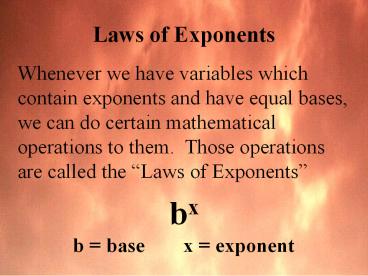
Laws of Exponents
Laws of exponents whenever we have variables which contain exponents and have equal bases, we can do certain mathematical operations to them. those operations are ... – powerpoint ppt presentation.
PowerShow.com is a leading presentation sharing website. It has millions of presentations already uploaded and available with 1,000s more being uploaded by its users every day. Whatever your area of interest, here you’ll be able to find and view presentations you’ll love and possibly download. And, best of all, it is completely free and easy to use.
You might even have a presentation you’d like to share with others. If so, just upload it to PowerShow.com. We’ll convert it to an HTML5 slideshow that includes all the media types you’ve already added: audio, video, music, pictures, animations and transition effects. Then you can share it with your target audience as well as PowerShow.com’s millions of monthly visitors. And, again, it’s all free.
About the Developers
PowerShow.com is brought to you by CrystalGraphics , the award-winning developer and market-leading publisher of rich-media enhancement products for presentations. Our product offerings include millions of PowerPoint templates, diagrams, animated 3D characters and more.


IMAGES
VIDEO
COMMENTS
4. Lesson 1: Laws of Exponents Law 1: Product Law aman = am+n When multiplying two powers with the same base, just add the exponents. 5. Lesson 1: Laws of Exponents Law 2: Quotient Law m a n = am-n a When dividing two powers with the same base, just subtract the exponents. 6.
The Laws of Exponents : Quotients. #5: Power of a quotient: Exponentiation distributes over division. 485 views • 5 slides. Laws of Exponents. Laws of Exponents. Whenever we have variables which contain exponents and have the same base, we can do certain mathematical operations to them. Those operations are called the "Laws of Exponents ...
Exponents Power base exponent 53 means 3 factors of 5 or 5 x 5 x 5 The Laws of Exponents: Exponential form: The exponent of a power indicates how many times the base multiplies itself. n factors of x #1: Multiplying Powers (Product of Powers): If you are multiplying Powers with the same base, KEEP the BASE & ADD the EXPONENTS!
The Laws of Exponents. Exponents exponent Power base 53 means 3 factors of 5 or 5 x 5 x 5. The Laws of Exponents: Exponential form:The exponent of a power indicates how many times the base multiplies itself. n factors of x. #1: Multiplying Powers (Product of Powers): If you are multiplying Powers with the same base, KEEP the BASE & ADD the ...
8.EEI.1 Understand and apply the laws of exponents (i.e. product rule, quotient rule, power to a power, product to a power, quotient to a power, zero power property, negative exponents) to simplify numerical expressions that include integer exponents. Ex: n xn = n =n.
Laws of Exponents. Lesson 2. Law 4: Zero Exponent. ... When the video is finished, please return to the PowerPoint presentation. Some Practice Problems • Simplify fully: Answers to Practice Problems. Law 5: Negative Exponents. Click on the link below for a video on negative exponents.
Get ready to learn the properties of exponents with this fun, visual template! This simple design features a doodle-style visual with a playful font to help your students stay engaged throughout the lesson. They'll learn about the power of exponents, the rules of multiplication and division, and how to apply the properties in real-examples.
Download ppt "Laws of Exponents: Multiplication." Similar presentations . Simplifying a Variable Expression. Laws of Exponents: Dividing Monomials Division Rules for Exponents. ... Laws of Exponents. Review An exponent tells you how many times the base is multiplied by itself. h 5 means h∙ h∙ h∙ h∙ h Any number to the zero power.
Do you want to learn the rules of exponents in a fun and interactive way? Check out this PowerPoint presentation created by the Franklin Township Public Schools, a district that offers high-quality curriculum and instruction, innovative technology, and diverse programs for students of all ages and backgrounds.
Then we need to remind ourselves that when we raise a power to a power, we multiply the exponents. = 22(x5)2 (y3)2 Raise each factor in the numerator and denominator to the second power. = 4x10 y6 Simplify: 22 = 4, (x5)2 = x10, and (y3)2 = y6. Exercise 5.5.13. Simplify: ( a4 3b2)3.
This resource, Sixth Grade Laws of Exponents PowerPoint & Google Slides, is an excellent way to engage your students in learning about the laws of exponents. Throughout the PowerPoint, there is an opportunity for your students to collaborate and practice problems, engaging them in the lesson each step of the way! After you're finished with this PowerPoint, why not choose some more ...
6. POWER OF A POWER To raise a number in exponential form toa power, multiply the exponents. (am)n= am∙n. 7. POWER OF A PRODUCT To find a power of a product, find thepower of each factor and multiply. (ab)m= ambm. 8. POWER OF ZERO Any nonzero number raised to thepower of zero is one.a0= 1. 9.
Laws of Exponents Lesson 1. Law 1: Product Rule Click on the link below for a video on the product rule. ... When the video is finished, please return to the PowerPoint presentation. Some Practice Problems •Simplify fully: Answers to Practice Problems. Summary of Rules Learned •Product Rule: •Quotient Rule:
Laws of Exponents. Exponents are also called Powers or Indices. The exponent of a number says how many times to use the number in a multiplication. In this example: 82 = 8 × 8 = 64. In words: 8 2 could be called "8 to the second power", "8 to the power 2" or simply "8 squared". Try it yourself:
Laws of Exponents is related to Grade 5 and focuses on standards 5.NBT.2. This Lumos presentation viewer page not only allows you to view and download Laws of Exponents but also view questions, videos, apps, books and other resources related to 5.NBT.2. Laws of Exponents is related to Grade 5 and focuses on standards 5.NBT.A.2.
6.1 Laws of Exponents. Description: The nth power of b, written , where n is a positive integer is: for n factors b is called the . n is called the . base exponent 1. - PowerPoint PPT presentation. Number of Views: 393. Avg rating:3.0/5.0. Slides: 10. Provided by: Carly158. Category:
Laws of Exponents: Exponents are a way of representing very large or very small numbers. Exponent rules are the laws of the exponents that are used to solve various exponents' problems. The multiplication, division, and other operations on exponents can be achieved using these laws of exponents. There are different rules of exponents also ...
Hi ka-TeachTok! This video is about a PowerPoint Presentation in Grade 7 topic.Starting today, I will post random presentations to be used by everyone. I hop...
For today's topic, we are going to talk about the "Law of Exponents".In our previous video, we already define what is exponent all about. If you haven't watc...
The Federal Trade Commission (FTC) issued a new rule on April 23, 2024, banning new non-compete agreements in all employment contexts. The highly anticipated rule, which was first proposed in draft form in January 2023, is expected to have significant impacts on employers in a wide swath of industries who have traditionally relied on non-competes to protect company secrets and intellectual ...
Fewer than 1% of workers are estimated to be senior executives under the final rule. Specifically, the final rule defines the term "senior executive" to refer to workers earning more than $151,164 annually who are in a "policy-making position.". The FTC estimates that banning noncompetes will result in: Reduced health care costs: $74 ...
Laws of Exponents. Description: Laws of Exponents Whenever we have variables which contain exponents and have equal bases, we can do certain mathematical operations to them. Those operations are ... - PowerPoint PPT presentation. Number of Views: 392. Avg rating:3.0/5.0. Slides: 9. Provided by: ChesterAr.